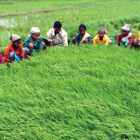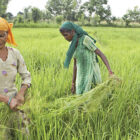Frustration on the farms has reached an inflexion point and all of Prime Minister Narendra Modi’s promises could actually go against him.
Frustration on the farms has reached an inflexion point and all of Prime Minis-ter Narendra Modi’s promises could actually go against him. It is important to understand the “farmer’s identity” to be able to gauge if the farmers’ anger can become a potent political force in 2019. Identities rarely exist in neat silos and that is true of the farmer as well. In rural India, identities are multi-layered with people identifying themselves along multiple lines: religion, caste, language, oc-cupation, region, land ownership, positions in the government or simply aspira-tions.
Livelihoods in villages are no longer self-sustained but are tied to market forces. In the quest to increase farm productivity, agriculture universities introduced monoculture. As a result, farmers are now dependent on markets for not only selling their cash crops but their regular produce as well. The latest NSSO sur-vey reveals that 48 per cent of the income of agricultural households comes from cultivation. Ever since the forces of liberalisation were unleashed, millions have been forced to leave villages to look for work. Each migrating family has swelled the rank of consumers. Today, a majority of farmer families have at least one earning member working off the farm. As consumers, they too are hurt by the rising food prices.
The implementation of the Mandal Commission Report and the institution of panchayati raj have changed the social fabric, politics and the traditional power structure in villages. Identity politics based on caste-backed job reservations has proved a stronger glue than associations that draw on occupational identities. Farmer leaders steering clear of the caste divide have lost their relevance in In-dian politics. The presumption that farmers are not a potent political force has resulted in a vacuum, where there are hardly any farmer leaders in the top eche-lons of political parties. The leadership space has been ceded to those who have never farmed, are not dependent on agriculture for their livelihood, own busi-nesses, live in cities or have children who work abroad. Farmers do not easily repose trust in such leaders. Therefore, the farmer agitations amount to little more than sound and fury. The urban electorate’s support for farmer agitations is deceptive; an illusion that will last till inflation is low.
Political parties and their leaders have promised simple solutions to complex problems. The majority of farmer groups are aligned to political groups whose agendas draw on populist manifestos, which cannot be implemented. Most times, these documents make conflicting promises like subsidised inputs, C2+50 per cent MSP, organic farming, assured procurement, cash transfers, income se-curity, loan waiver, continued PDS, universal basic income and universal healthcare and education. Farmers latch on to the parties that make these prom-ises in the hope of improving their lives even though they do not expect gov-ernments to fulfil promises. Populist commitments like farm loan waiver do not topple governments but will come to haunt new dispensations in the future be-cause on the polling day, hate is a far stronger emotion than hope.
Across the country, farmers are never uniformly distressed or satisfied to find a common cause. Farmers growing different crops have different peaks and troughs in terms of profitability. Sops for selected crops appease only a certain section of farmers at any given time. The village polity is also splintered as mul-tiple contestants jostle for a few panchayat seats. Farmers get to vote every year-and-a-half in a variety of elections like those to the panchayats, zila parishads, legislative assemblies or Parliament. This allows disgruntled farmers to vent their frustration against the establishment, which would otherwise force the kettle to blow-up. The hue and cry of the farmer protest dissipates even before the farm-ers reach their homes.
The message is clear though: farmers can band together to defeat ruling regimes. Farmers were sold a dream and felt deceived and the results in Rajasthan, Chhattisgarh and even Madhya Pradesh substantiate this. However, a vote against the BJP must not be considered a vote for the Congress. It may appear so in a bipolar contest but many regional parties will be in the fray in the 2019 elections. Like in Telangana, the farmer vote could get split between mainstream and regional parties. For the leaderless protests and long-standing grievances of the farmers to morph into a nationwide movement that could give a headwind to the Congress, the party needs to find and project a farmer’s leadership; one with which the farmers can connect. This is a significant moment in Indian politics.
Frustration on the farms has reached an inflexion point and all of Prime Minis-ter Narendra Modi’s promises could actually go against him. It is important to understand the “farmer’s identity” to be able to gauge if the farmers’ anger can become a potent political force in 2019. Identities rarely exist in neat silos and that is true of the farmer as well. In rural India, identities are multi-layered with people identifying themselves along multiple lines: religion, caste, language, oc-cupation, region, land ownership, positions in the government or simply aspira-tions.
Livelihoods in villages are no longer self-sustained but are tied to market forces. In the quest to increase farm productivity, agriculture universities introduced monoculture. As a result, farmers are now dependent on markets for not only selling their cash crops but their regular produce as well. The latest NSSO sur-vey reveals that 48 per cent of the income of agricultural households comes from cultivation. Ever since the forces of liberalisation were unleashed, millions have been forced to leave villages to look for work. Each migrating family has swelled the rank of consumers. Today, a majority of farmer families have at least one earning member working off the farm. As consumers, they too are hurt by the rising food prices.
The implementation of the Mandal Commission Report and the institution of panchayati raj have changed the social fabric, politics and the traditional power structure in villages. Identity politics based on caste-backed job reservations has proved a stronger glue than associations that draw on occupational identities. Farmer leaders steering clear of the caste divide have lost their relevance in In-dian politics. The presumption that farmers are not a potent political force has resulted in a vacuum, where there are hardly any farmer leaders in the top eche-lons of political parties. The leadership space has been ceded to those who have never farmed, are not dependent on agriculture for their livelihood, own busi-nesses, live in cities or have children who work abroad. Farmers do not easily repose trust in such leaders. Therefore, the farmer agitations amount to little more than sound and fury. The urban electorate’s support for farmer agitations is deceptive; an illusion that will last till inflation is low.
Political parties and their leaders have promised simple solutions to complex problems. The majority of farmer groups are aligned to political groups whose agendas draw on populist manifestos, which cannot be implemented. Most times, these documents make conflicting promises like subsidised inputs, C2+50 per cent MSP, organic farming, assured procurement, cash transfers, income se-curity, loan waiver, continued PDS, universal basic income and universal healthcare and education. Farmers latch on to the parties that make these prom-ises in the hope of improving their lives even though they do not expect gov-ernments to fulfil promises. Populist commitments like farm loan waiver do not topple governments but will come to haunt new dispensations in the future be-cause on the polling day, hate is a far stronger emotion than hope.
Across the country, farmers are never uniformly distressed or satisfied to find a common cause. Farmers growing different crops have different peaks and troughs in terms of profitability. Sops for selected crops appease only a certain section of farmers at any given time. The village polity is also splintered as mul-tiple contestants jostle for a few panchayat seats. Farmers get to vote every year-and-a-half in a variety of elections like those to the panchayats, zila parishads, legislative assemblies or Parliament. This allows disgruntled farmers to vent their frustration against the establishment, which would otherwise force the kettle to blow-up. The hue and cry of the farmer protest dissipates even before the farm-ers reach their homes.
The message is clear though: farmers can band together to defeat ruling regimes. Farmers were sold a dream and felt deceived and the results in Rajasthan, Chhattisgarh and even Madhya Pradesh substantiate this. However, a vote against the BJP must not be considered a vote for the Congress. It may appear so in a bipolar contest but many regional parties will be in the fray in the 2019 elections. Like in Telangana, the farmer vote could get split between mainstream and regional parties. For the leaderless protests and long-standing grievances of the farmers to morph into a nationwide movement that could give a headwind to the Congress, the party needs to find and project a farmer’s leadership; one with which the farmers can connect. This is a significant moment in Indian politics.




